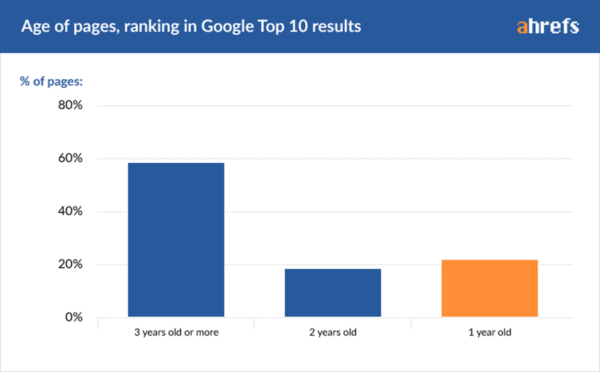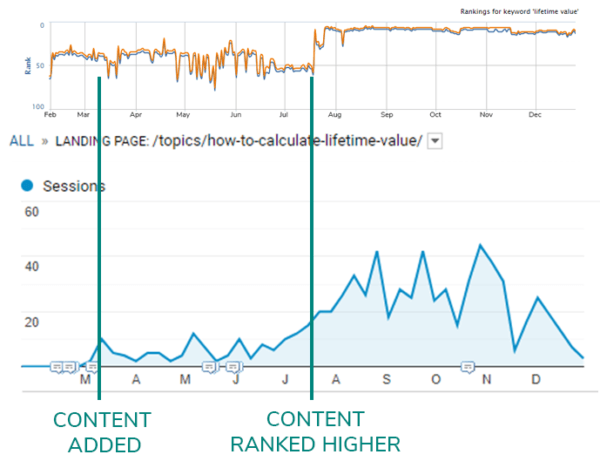From time to time, we talk to company or department leaders who are interested in SEO but uncertain of its effectiveness. Some of them ask for a 90-day trial of SEO to see if it works or not; after all, incredible results can come in just 90 days from paid media. But we always say no, because 90 days simply isn’t enough time to determine if SEO “works.”
Why Does SEO Take So Long: It Takes Time for Search Engines to Trust Pages
In a perfect world, you would update or create a page and see results on search engine results pages (SERPs) in a day or two. Unfortunately, it doesn’t work that way. Search engines parse trillions of GB of data every day, which means it takes a while for search engines to notice changes to pages on your site and to determine what impact those changes should have on your site’s authority.
Website authority is a search engine’s numerical metric that estimates how valuable your site is to visitors. Sites that deliver great experiences and content, with inbound links from other well-regarded websites, tend to have higher authority. Sites with higher authority rank well and changes to their content are noticed relatively quickly by search engines.
Of course, “relatively” is the operative word here. One B2B SaaS company, with an extremely high site authority of 87 out of 100, adjusted the content on their site to rank higher for a group of terms. As part of their SaaS marketing strategy, they added a relevant content page to their site in March, but the changes weren’t reflected on SERPs until late July That’s well past 90 days – and on a high-authority site.
 Why Does SEO Take So Long: New Sites and Content Are at a Disadvantage
Why Does SEO Take So Long: New Sites and Content Are at a Disadvantage
In 2017, Ahrefs published the results of a study that gathered the top 10 results for 2 million random keywords. Overall, the average age of a page on the top 10 was 3+ years old, and 80% of the pages in the top 10 were 2 or more years old.

[graph from ahrefs study]
The study also determined that only 5.7% of newly created pages will rank in the top 10 within a year. (For high-authority sites such as our client, that percentage nearly doubled to 10.8%, but the odds are still low.)
Additionally, even more established sites have to compete with 800-pound gorillas, such as Wikipedia, whose authority and age are so advanced that it’s very difficult to unseat them. Plus, the biggest gorilla of them all is Google itself, which strives to answer as many searcher questions as possible on its search engine results page, meaning your site may not get much traffic, even from a high-ranking result.
Why Does SEO Take So Long: Implementation Isn’t Always Simple or Fast
Allocating internal resources to implement SEO recommendations can be a challenge, especially if those resources are spread out over different departments. The very nature of large corporations tends to hinder interdepartmental communication and coordination. Additionally, teams often have different missions, priorities, and focuses, which can result in extremely long implementation timelines.
Content improvements in particular can require a long timeline. Quality content takes time to develop and create, especially when the person or team developing the content aren’t subject matter experts on the content topics.
Position Yourself for SEO Success
While there’s no escaping the external factors that affect rankings and visibility, there are several ways to position your site to make the most of SEO improvements:
- Choose your keywords wisely: Understand that ranking for high-search-volume keywords is going to be a long, difficult process, so start by going after keywords where your site authority is equal to or better than at least one page in the top 10
- Or follow your competitors: You could approach this process from a different perspective by finding competitors with a similar domain authority, then targeting the topics and keywords they rank for
- Produce quality content at a strong pace: Regularly introducing “fresh” content over time increases your site’s authority by expanding the scope of keywords for which your site ranks. A regular supply of high-quality content decreases the time to rank for the new content’s keywords
- Make sure your site is technically sound: Conduct an SEO audit to determine how well previous recommendations have been implemented, and to establish which new technical tasks will need to be completed. For instance, an education client was able to increase their organic click-through rate by 38% and their organic visibility by 40% by fixing their meta content issues
Even these steps will take some time to complete before making additional SEO improvements, so once again, 90 days is simply not enough time for SEO to “work.” However, we can tell you how to get the fastest and most sustainable gains from your company’s site if you’d like to talk to us about your SEO goals.
Why Does SEO Take So Long: It Takes Time for Search Engines to Trust Pages
In a perfect world, you would update or create a page and see results on search engine results pages (SERPs) in a day or two. Unfortunately, it doesn’t work that way. Search engines parse trillions of GB of data every day, which means it takes a while for search engines to notice changes to pages on your site and to determine what impact those changes should have on your site’s authority. Website authority is a search engine’s numerical metric that estimates how valuable your site is to visitors. Sites that deliver great experiences and content, with inbound links from other well-regarded websites, tend to have higher authority. Sites with higher authority rank well and changes to their content are noticed relatively quickly by search engines. Of course, “relatively” is the operative word here. One B2B SaaS company, with an extremely high site authority of 87 out of 100, adjusted the content on their site to rank higher for a group of terms. As part of their SaaS marketing strategy, they added a relevant content page to their site in March, but the changes weren’t reflected on SERPs until late July That’s well past 90 days – and on a high-authority site. Why Does SEO Take So Long: New Sites and Content Are at a Disadvantage
Why Does SEO Take So Long: New Sites and Content Are at a Disadvantage
In 2017, Ahrefs published the results of a study that gathered the top 10 results for 2 million random keywords. Overall, the average age of a page on the top 10 was 3+ years old, and 80% of the pages in the top 10 were 2 or more years old.

[graph from ahrefs study]
The study also determined that only 5.7% of newly created pages will rank in the top 10 within a year. (For high-authority sites such as our client, that percentage nearly doubled to 10.8%, but the odds are still low.) Additionally, even more established sites have to compete with 800-pound gorillas, such as Wikipedia, whose authority and age are so advanced that it’s very difficult to unseat them. Plus, the biggest gorilla of them all is Google itself, which strives to answer as many searcher questions as possible on its search engine results page, meaning your site may not get much traffic, even from a high-ranking result.Why Does SEO Take So Long: Implementation Isn’t Always Simple or Fast
Allocating internal resources to implement SEO recommendations can be a challenge, especially if those resources are spread out over different departments. The very nature of large corporations tends to hinder interdepartmental communication and coordination. Additionally, teams often have different missions, priorities, and focuses, which can result in extremely long implementation timelines. Content improvements in particular can require a long timeline. Quality content takes time to develop and create, especially when the person or team developing the content aren’t subject matter experts on the content topics.Position Yourself for SEO Success
While there’s no escaping the external factors that affect rankings and visibility, there are several ways to position your site to make the most of SEO improvements:- Choose your keywords wisely: Understand that ranking for high-search-volume keywords is going to be a long, difficult process, so start by going after keywords where your site authority is equal to or better than at least one page in the top 10
- Or follow your competitors: You could approach this process from a different perspective by finding competitors with a similar domain authority, then targeting the topics and keywords they rank for
- Produce quality content at a strong pace: Regularly introducing “fresh” content over time increases your site’s authority by expanding the scope of keywords for which your site ranks. A regular supply of high-quality content decreases the time to rank for the new content’s keywords
- Make sure your site is technically sound: Conduct an SEO audit to determine how well previous recommendations have been implemented, and to establish which new technical tasks will need to be completed. For instance, an education client was able to increase their organic click-through rate by 38% and their organic visibility by 40% by fixing their meta content issues


 Why Does SEO Take So Long: New Sites and Content Are at a Disadvantage
Why Does SEO Take So Long: New Sites and Content Are at a Disadvantage